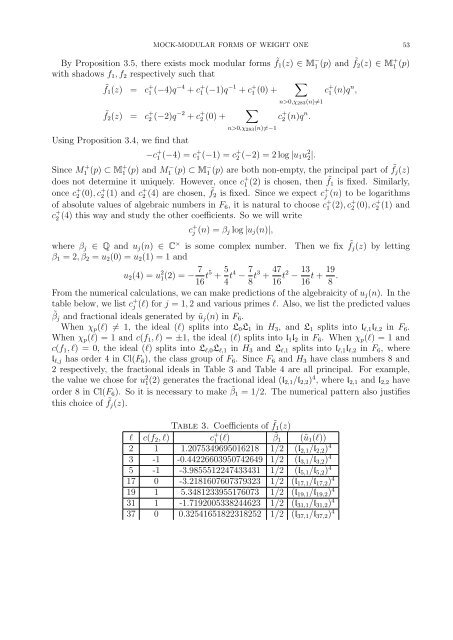Mock-modular forms of weight one - UCLA Department of Mathematics
Mock-modular forms of weight one - UCLA Department of Mathematics
Mock-modular forms of weight one - UCLA Department of Mathematics
You also want an ePaper? Increase the reach of your titles
YUMPU automatically turns print PDFs into web optimized ePapers that Google loves.
MOCK-MODULAR FORMS OF WEIGHT ONE 53<br />
By Proposition 3.5, there exists mock <strong>modular</strong> <strong>forms</strong> ˜f 1 (z) ∈ M − 1 (p) and ˜f 2 (z) ∈ M + 1 (p)<br />
with shadows f 1 , f 2 respectively such that<br />
∑<br />
˜f 1 (z) = c + 1 (−4)q −4 + c + 1 (−1)q −1 + c + 1 (0) +<br />
c + 1 (n)q n ,<br />
˜f 2 (z) = c + 2 (−2)q −2 + c + 2 (0) +<br />
Using Proposition 3.4, we find that<br />
∑<br />
n>0,χ 283 (n)≠−1<br />
n>0,χ 283 (n)≠1<br />
c + 2 (n)q n .<br />
−c + 1 (−4) = c + 1 (−1) = c + 2 (−2) = 2 log |u 1 u 2 2|.<br />
Since M 1 + (p) ⊂ M + 1 (p) and M1 − (p) ⊂ M − 1 (p) are both non-empty, the principal part <strong>of</strong> ˜f j (z)<br />
does not determine it uniquely. However, once c + 1 (2) is chosen, then ˜f 1 is fixed. Similarly,<br />
once c + 2 (0), c + 2 (1) and c + 2 (4) are chosen, ˜f2 is fixed. Since we expect c + j (n) to be logarithms<br />
<strong>of</strong> absolute values <strong>of</strong> algebraic numbers in F 6 , it is natural to choose c + 1 (2), c + 2 (0), c + 2 (1) and<br />
c + 2 (4) this way and study the other coefficients. So we will write<br />
c + j (n) = β j log |u j (n)|,<br />
where β j ∈ Q and u j (n) ∈ C × is some complex number. Then we fix ˜f j (z) by letting<br />
β 1 = 2, β 2 = u 2 (0) = u 2 (1) = 1 and<br />
u 2 (4) = u 2 1(2) = − 7 16 t5 + 5 4 t4 − 7 8 t3 + 47<br />
16 t2 − 13<br />
16 t + 19<br />
8 .<br />
From the numerical calculations, we can make predictions <strong>of</strong> the algebraicity <strong>of</strong> u j (n). In the<br />
table below, we list c + j (l) for j = 1, 2 and various primes l. Also, we list the predicted values<br />
˜β j and fractional ideals generated by ũ j (n) in F 6 .<br />
When χ p (l) ≠ 1, the ideal (l) splits into L 0 L 1 in H 3 , and L 1 splits into l l,1 l l,2 in F 6 .<br />
When χ p (l) = 1 and c(f 1 , l) = ±1, the ideal (l) splits into l 1 l 2 in F 6 . When χ p (l) = 1 and<br />
c(f 1 , l) = 0, the ideal (l) splits into L l,0 L l,1 in H 3 and L l,1 splits into l l,1 l l,2 in F 6 , where<br />
l l,j has order 4 in Cl(F 6 ), the class group <strong>of</strong> F 6 . Since F 6 and H 3 have class numbers 8 and<br />
2 respectively, the fractional ideals in Table 3 and Table 4 are all principal. For example,<br />
the value we chose for u 2 1(2) generates the fractional ideal (l 2,1 /l 2,2 ) 4 , where l 2,1 and l 2,2 have<br />
order 8 in Cl(F 6 ). So it is necessary to make ˜β 1 = 1/2. The numerical pattern also justifies<br />
this choice <strong>of</strong> ˜f j (z).<br />
Table 3. Coefficients <strong>of</strong> ˜f 1 (z)<br />
l c(f 2 , l) c + 1 (l) ˜β1 (ũ 1 (l))<br />
2 1 1.2075349695016218 1/2 (l 2,1 /l 2,2 ) 4<br />
3 -1 -0.44226603950742649 1/2 (l 3,1 /l 3,2 ) 4<br />
5 -1 -3.9855512247433431 1/2 (l 5,1 /l 5,2 ) 4<br />
17 0 -3.2181607607379323 1/2 (l 17,1 /l 17,2 ) 4<br />
19 1 5.3481233955176073 1/2 (l 19,1 /l 19,2 ) 4<br />
31 1 -1.7192005338244623 1/2 (l 31,1 /l 31,2 ) 4<br />
37 0 0.32541651822318252 1/2 (l 37,1 /l 37,2 ) 4
















